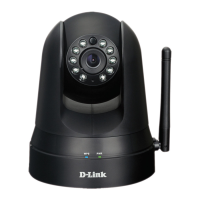30D-Link DCS-5010L User Manual 30
Section 4 - Conguration
Network Setup
Select DHCP if you have a DHCP server running on your network
and would like a dynamic IP address to be assigned to your camera
automatically.
Select this connection type if your Internet Service Provider (ISP)
or network administrator has provided you with a static or xed IP
address and other network information for your camera.
IP Address: Enter the xed IP Address for your camera.
Subnet Mask: Enter the Subnet Mask for your network. This value
is used to determine if the destination is the same subnet as host
devices. (The default value is 255.255.255.0.)
Default Gateway: Enter the address for the gateway used to forward
data to destinations in a dierent subnet. Invalid gateway settings
may cause the failure of transmissions.
Primary DNS: Enter the IP address for the primary domain name server
that translates names to IP addresses.
Secondary DNS: Enter the IP address for the secondary domain name
server to backup the Primary DNS.
If your camera is directly connected to the Internet through a DSL
modem, you may connect to the Internet using PPPoE. Click PPPoE
and enter the User ID and Password provided to you by your ISP or
network administrator.
You may congure a second HTTP port that will allow you to connect
to the camera using a standard Web browser. The port can be set to a
number other than the default TCP port of 80. A corresponding port
must be opened on the router. For example, if the port is changed
to 1010, users must type http://192.168.0.100:1010 instead of only
http://192.168.0.100.
Enable this setting to congure your camera as a UPnP (Universal Plug
and Play) device in the network.
If you enable UPnP port forwarding, it will allow the camera to
communicate with a UPnP compatible network router for simplied
local network access and remote access using the Internet.
DHCP:
Static IP
Address:
PPPoE
Port Settings:
UPnP Settings:
UPnP Port
Forwarding:
This section allows you to congure your network settings.

